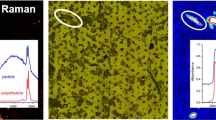Abstract
This work represents a first systematic approach to the size-based elemental quantification and size estimation of metal(loid) oxide nanoparticles such as silica (SiO2) in a real food matrix using asymmetric flow field-flow fractionation coupled online with inductively coupled plasma mass spectrometry (ICP-MS) and multi-angle light scattering (MALS) and offline with transmission electron microscopy (TEM) with energy-dispersive X-ray analysis (EDAX). Coffee creamer was selected as the model sample since it is known to contain silica as well as metal oxides such as titania at the milligramme per kilogramme levels. Optimisation of sample preparation conditions such as matrix-to-solvent ratio, defatting with organic solvents and sonication time that may affect nanoparticle size and size distribution in suspensions was investigated. Special attention was paid to the selection of conditions that minimise particle transformation during sample preparation and analysis. The coffee creamer matrix components were found to stabilise food grade SiO2 particles in comparison with water suspensions whilst no significant effect of defatting using hexane was found. The use of sample preparation procedures that mimic food cooking in real life was also investigated regarding their effect on particle size and particle size distribution of silica nanoparticles in the investigated food matrix; no significant effect of the water temperature ranging from ambient temperature to 60 °C was observed. Field-flow fractionation coupled to inductively coupled plasma-mass spectrometry (FFF-ICP-MS) analysis of extracts of both unspiked coffee creamer and coffee creamer spiked with food grade silicon dioxide, using different approaches for size estimation, enabled determination of SiO2 size-based speciation. Element-specific detection by ICP-MS and post-FFF calibration with elemental calibration standards was used to determine the elemental composition of size fractions separated online by FFF. Quantitative data on mass balance is provided for the size-based speciation of the investigated inorganic nano-objects in the complex matrix. The combination of FFF with offline fractionation by filtration and with detection by ICP-MS and TEM/EDAX has been proven essential to provide reliable information of nanoparticle size in the complex food matrix.

Characterisation of silica nanoparticles in a coffee creamer matrix using FFF-based methodology





Similar content being viewed by others
References
CEN ISO/TS 27687:2009
Weir A, Westerhoff P, Fabricius L, Hristovski K, von Goetz N (2012) Environ Sci Technol 46:2242–2250
Dekkers S, Krystek P, Peters RJB, Lankveld DPK, Bokkers BGH, van Hoeven-Arentzen PH, Bouwmeester H, Oomen AG (2011) Nanotoxicology 5:393–405
Peters R, Kramer E, Oomen AG, Rivera ZEH, Oegema G, Tromp PC, Fokkink R, Rietveld A, Marvin HJP, Weigel S, Peijnenburg AACM, Bouwmeester H (2012) ACS Nano 6:2441–2451
Calzolai L, Gilliland D, Rossi F (2012) Food Addit Contam 29:1183–1193
House of Lords Report on “Nanotechnologies and Food”, Science and Technology Committee, 2010, Volume I: Report, HL Paper No 22-I
House of Lords Report on “Nanotechnologies and Food”, Science and Technology Committee, 2010, Volume II: Evidence, HL Paper No 22-II
Linsinger T, Roebben G, Solans C, Ramsch R (2011) Trends Anal Chem 30:18–27
Tiede K, Boxall ABA, Tear SP, Lewis J, David H, Hassellov M (2008) Food Addit Contam 25:795–821
von der Kammer F, Legros S, Larsen EH, Loeschner K, Hofmann T (2011) Trends Anal Chem 30:425–436
Nischwitz V, Goenaga-Infante H (2012) J Anal At Spectrom 27:1084–1092
Loeschner K, Navratilova J, Legros S, Wagner S, Grombe R, Snell J, von der Kammer F, Larsen EH (2013) J Chromatogr A 1272:116–125
Saeseaw S, Shiowatana J, Siripinyanond A (2005) Food Res Int 38:777–786
Hupfeld S, Ausbacher D, Brandl M (2009) J Sep Sci 32:1465–1470
Contado C, Ravani L, Pasarella M (2013) Anal Chim Acta 788:183–192
Nischwitz V, Berthele A, Michalke B (2010) J Anal At Spectrom 25:1130–1137
Schramel P, Wendler I, Knapp G (1996) Fresenius J Anal Chem 356:512–514
Hagendorfer H, Kaegi R, Traber J, Mertens SFL, Scherrers R, Ludwig C, Ulrich A (2011) Anal Chim Acta 706:367–378
Tadjiki S, Assemi S, Deering CE, Veranth JM, Miller JD (2009) J Nanopart Res 11:981–988
Gigault J, Hackley VA (2013) Anal Bioanal Chem 405:6251–6258
Spallek M J, Wallner A, Jünger R, Application Note 0028, Postnova Analytics GmbH
Acknowledgments
Funding from the UK National Measurement Office is gratefully acknowledged. The authors would also like to thank Trevor Havard from Postnova Analytics for technical support.
Author information
Authors and Affiliations
Corresponding author
Additional information
Published in the topical collection Characterisation of Nanomaterials in Biological Samples with guest editors Heidi Goenaga-Infante and Erik H. Larsen.
Electronic supplementary material
Below is the link to the electronic supplementary material.
ESM 1
(PDF 197 kb)
Rights and permissions
About this article
Cite this article
Heroult, J., Nischwitz, V., Bartczak, D. et al. The potential of asymmetric flow field-flow fractionation hyphenated to multiple detectors for the quantification and size estimation of silica nanoparticles in a food matrix. Anal Bioanal Chem 406, 3919–3927 (2014). https://doi.org/10.1007/s00216-014-7831-7
Received:
Revised:
Accepted:
Published:
Issue Date:
DOI: https://doi.org/10.1007/s00216-014-7831-7




